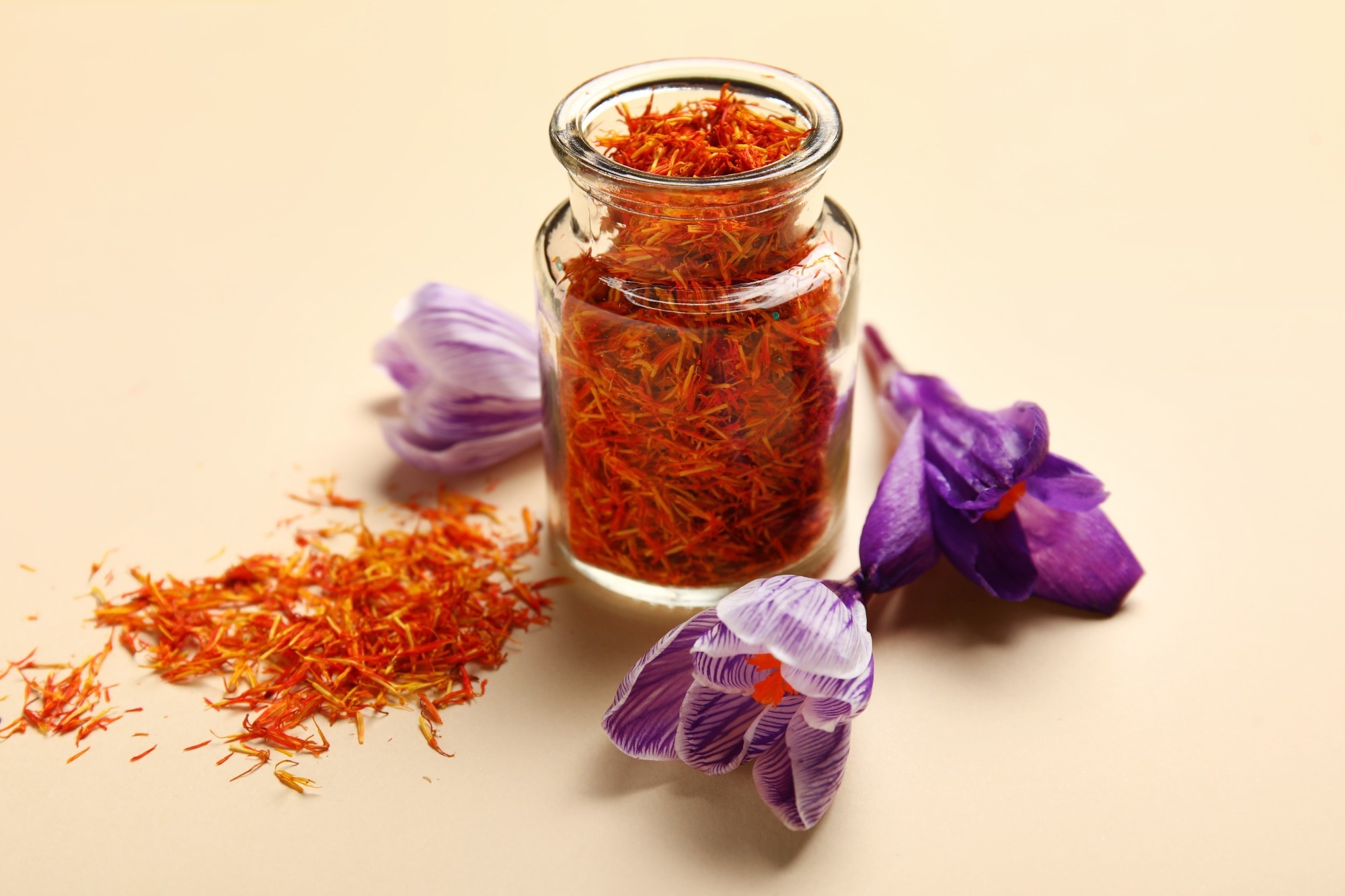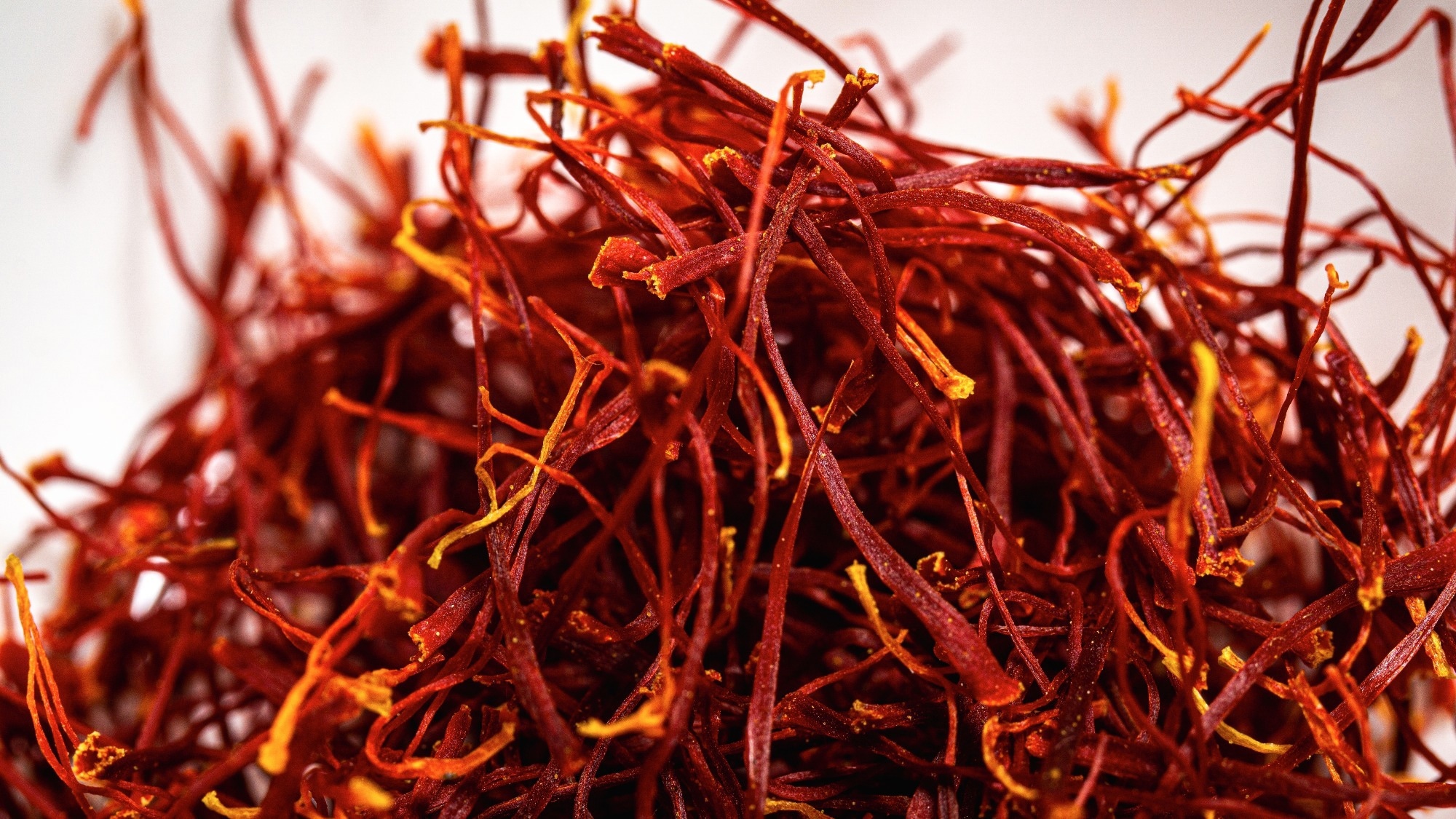Introduction
Tracing the origins and potent compounds of saffron
Cultural and historical relevance
Antioxidant effects
How saffron fights inflammation
The role of saffron in protecting cognition
Anticancer potential
Clinical evidence
Safety, dosage, and side effects
Market and research trends
Conclusion
References
Further reading
Saffron, the world’s most precious spice, is emerging from ancient tradition to modern clinical research as a promising natural agent for mood, memory, and metabolic health, though quality and safety questions remain.
 Dried saffron spice with flower. Image Credit: Pixel-Shot / Shutterstock.com
Dried saffron spice with flower. Image Credit: Pixel-Shot / Shutterstock.com
Introduction
Saffron (Crocus sativus L.) is widely known for its vibrant hue, delicate aroma, and rich cultural symbolism. With increasing interest in evidence-based herbal therapeutics, particularly following the coronavirus disease 2019 (COVID-19) pandemic, saffron has been increasingly studied for its potential health benefits, particularly for the management of neurological, metabolic, and inflammatory conditions.1-3
Tracing the origins and potent compounds of saffron
Saffron is harvested from the crimson stigmas of C. sativus, a sterile triploid plant that is believed to have originated through selective breeding of wild C. cartwrightianus in ancient Greece.4 Each flower yields only three stigmas, which increases the labor and cost requirements associated with saffron harvesting.
Phytochemical analyses have identified four major bioactive constituents of saffron, of which include crocin, crocetin, picrocrocin, and safranal.
Crocin is a carotenoid glycoside responsible for saffron's color and antioxidant properties. Comparatively, crocetin is an aglycone form of crocin with notable anti-inflammatory and neuroprotective activity. Picrocrocin contributes to saffron's characteristic bitter taste, whereas safranal is a volatile essential oil that has been studied for its anticonvulsant and antidepressant potential.5
Variability in the chemical composition, harvest conditions, and region-specific storage practices has prevented standardization attempts required for commercial production. To overcome these limitations, quality control methods like high-performance liquid chromatography (HPLC) and DNA barcoding are used for pre-clinical and clinical studies.5
Cultural and historical relevance
A review of historical and archaeological evidence suggests that ancient Persians used saffron to dye robes and as a mood enhancer. In India, saffron has historically been offered to deities in Hindu rituals and forms a key ingredient in several traditional dishes.6 In Ayurvedic (Indian) and Unani (Greek) medicine, saffron was historically prescribed for respiratory, cardiovascular, and gynecological disorders, as well as enhancing memory and libido.3,6
Saffron, both the herb and its characteristic color, is also associated with symbolism for purity, luxury, and spiritual elevation. Whereas Buddhist religious traditions consider saffron robes a sign of renunciation, Kashmiri cuisine often incorporates saffron into their foods to represent hospitality and celebration. These symbolic associations have contributed to saffron's enduring demand and high market value.6
As the world’s most expensive spice, the cost of saffron currently ranges from $5,000 to $10,000/kilogram globally.7

Organic pure saffron. Image Credit: scindler / Shutterstock.com
Antioxidant effects
Recent research suggests that saffron's bioactive constituents, especially crocin and crocetin, are potent scavengers of reactive oxygen species (ROS). Saffron can also inhibit lipid peroxidation activity and enhance the activity of endogenous antioxidant enzymes such as superoxide dismutase (SOD) and glutathione peroxidase (GPx), both of which further contribute to the antioxidant effects of saffron.8
How saffron fights inflammation
Saffron can suppress the expression of pro-inflammatory cytokines including tumor necrosis factor-alpha (TNF-α), interleukin 1β (IL-1β), and IL-6 by inhibiting nuclear factor kappa-light-chain-enhancer of activated B cells (NF-κB signaling).3
These anti-inflammatory effects have led researchers to investigate the potential utility of saffron for the management of arthritis, atherosclerosis, and inflammatory bowel disease. The efficacy of saffron against chronic, age-associated cardiovascular and kidney diseases is also being explored.4
The role of saffron in protecting cognition
Saffron enhances hippocampal neurogenesis and inhibits β-amyloid aggregation, a key risk factor in Alzheimer's disease (AD) development and progression.1 Crocin may also improve synaptic plasticity and mitochondrial function in neuronal cells, further supporting cognitive health.
In one study, researchers concluded that saffron extracts and donepezil, a clinically prescribed anti-dementia medication, exhibit similar clinical efficacy, which highlights the potential utility of saffron as a neuroprotective neutraceutical.2
Anticancer potential
Limited data from in vitro studies suggest that certain bioactive compounds in saffron can induce apoptosis in various human and animal cancer cell lines. Saffron extracts have also been shown to inhibit angiogenesis and suppress tumor progression; however, large-scale human trials are needed to confirm these effects.
Clinical evidence
Several clinical studies have investigated the efficacy of saffron in treating mood disorders, cognitive decline, and metabolic dysfunction. A meta-analysis of seven randomized controlled trials (RCTs) found that saffron supplementation significantly reduced symptoms of major depressive disorder as compared to placebo, with these effects the result of modulated gamma-aminobutyric acid (GABA) receptor activity .1
In Alzheimer's disease, one RCT comparing 30 mg/day of saffron to donepezil over 22 weeks reported comparable cognitive improvements and fewer adverse events.2 Preliminary data also support the use of saffron for managing premenstrual syndrome (PMS), erectile dysfunction, and appetite control.3
Modest reductions in fasting glucose, low-density lipoprotein (LDL) cholesterol, and waist circumference levels have been associated with saffron extract supplementation over 8 to 12 weeks. Importantly, these small, short-term pilot trials used variable dosages and extract types, thus limiting their generalizability.3
Safety, dosage, and side effects
Saffron is generally considered safe at or below doses of 30 mg/day. Common dosages in clinical trials range from 15 to 30 mg/day, which are typically standardized for crocin or safranal content. Side effects are rare but may include nausea, dizziness, or dry mouth.1,3,5
Nevertheless, toxic effects have been reported when saffron doses exceed five g/day, with lethality observed at 20 g in animal models. Pregnant women are advised to avoid high doses due to the risk of uterine stimulation.4,5
Even when caution is maintained, quality concerns persist due to frequent adulteration with dyes or fillers. Thus, there remains an urgent need for validated analytical methods, certifications, and usage regulations.
Why Saffron Is The World's Most Expensive Spice
Market and research trends
Saffron is a widely used active ingredient in skincare products, fortified teas, and nootropic supplements. Nanotechnology-based drug delivery systems are also being explored to enhance the bioavailability and physiological stability of saffron bioactive compounds.10
Global saffron production is expanding beyond conventional regions like Iran and Kashmir to countries like Afghanistan, Spain, and Morocco. Meanwhile, consumer interest in plant-based wellness products has also led to an estimated 6.8% annual growth rate in the saffron supplement market, thereby reflecting rising global demand for saffron.11
Recently, researchers have developed advanced nanoformulations that may improve the pharmacokinetics of saffron, as well as identify synergistic combinations with other adaptogens or antidepressants. Personalized nutrition approaches targeting safe and natural cognitive and metabolic health may also incorporate saffron for its systemic health benefits.
Conclusions
Despite promising findings, additional prospective studies and clinical trials are needed to resolve uncertainties regarding optimal dosing, long-term safety, and efficacy across genetically and climatically diverse global populations. Standardization, authentication, and regulatory oversight will be crucial in ensuring quality and public trust.
References
- Lopresti, A. L., & Drummond, P. D. (2014). Saffron (Crocus sativus) for depression: A systematic review of clinical studies and examination of underlying antidepressant mechanisms of action. Human Psychopharmacology, 29(6), 517–527. DOI: 10.1002/hup.2434, https://onlinelibrary.wiley.com/doi/10.1002/hup.2434
- Akhondzadeh, S., Shafiee Sabet, M., Harirchian, M. H., Togha, M., Cheraghmakani, H., Razeghi, S., Hejazi, S. S., Yousefi, M. H., Alimardani, R., Jamshidi, A., Rezazadeh, S.-A., Yousefi, A., Zare, F., Moradi, A., & Vossoughi, A. (2009). A 22-week, multicenter, randomized, double-blind controlled trial of Crocus sativus in the treatment of mild-to-moderate Alzheimer’s disease. Psychopharmacology, 207(4), 637–643. DOI: 10.1007/s00213-009-1706-1, https://link.springer.com/article/10.1007/s00213-009-1706-1
- Moshiri, M., Vahabzadeh, M., & Hosseinzadeh, H. (2014). Clinical Applications of Saffron (Crocus sativus) and its Constituents: A Review. Drug Research, 65(06), 287–295. DOI: 10.1055/s-0034-1375681, https://www.thieme-connect.de/products/ejournals/abstract/10.1055/s-0034-1375681
- Mohtashami, L., Amiri, M. S., Ramezani, M., Emami, S. A., & Simal-Gandara, J. (2021). The genus Crocus L.: A review of ethnobotanical uses, phytochemistry and pharmacology. Industrial Crops and Products, 171, 113923. DOI: 10.1016/j.indcrop.2021.113923, https://www.sciencedirect.com/science/article/abs/pii/S0926669021006877?via%3Dihub
- Jafari, S.-M., Tsimidou, M. Z., Rajabi, H., & Kyriakoudi, A. (2020). Bioactive ingredients of saffron: extraction, analysis, applications. In Saffron (pp. 261–290). Elsevier. DOI: 10.1016/b978-0-12-818638-1.00016-2, https://www.sciencedirect.com/science/article/abs/pii/B9780128186381000162?via%3Dihub
- Leonti, M. (2011). The future is written: Impact of scripts on the cognition, selection, knowledge and transmission of medicinal plant use and its implications for ethnobotany and ethnopharmacology. Journal of Ethnopharmacology, 134(3), 542–555. DOI: 10.1016/j.jep.2011.01.017, https://www.sciencedirect.com/science/article/abs/pii/S0378874111000183?via%3Dihub
- Hooker, Lucy. “The Problem for the World’s Most Expensive Spice.” BBC News, 13 Sept. 2017, https://www.bbc.com/news/business-41110151 Accessed 04 July 2025.
- Abdian, S., Fakhri, S., Moradi, S. Z., Khirehgesh, M. R., & Echeverría, J. (2024). Saffron and its major constituents against neurodegenerative diseases: A mechanistic review. Phytomedicine, 135, 156097. DOI:10.1016/j.phymed.2024.156097, https://www.sciencedirect.com/science/article/abs/pii/S0944711324007542?via%3Dihub
- Gautam, Y., Srivastav, M., Mishra, P., Singh, M., Kausar, H., Rao, D. P., Srivastav, A., Kumari, L., Chauhan, R. P. S., & Verma, N. (2024). Saffron: A Comprehensive Review of its Cancer-Preventive and Curative Properties in Different Types of Cancer. Oriental Journal Of Chemistry, 40(3), 646–659. DOI:10.13005/ojc/400303, https://www.orientjchem.org/vol40no3/saffron-a-comprehensive-review-of-its-cancer-preventive-and-curative-properties-in-different-types-of-cancer/
- Garavand, F., Rahaee, S., Vahedikia, N., & Jafari, S. M. (2019). Different techniques for extraction and micro/nanoencapsulation of saffron bioactive ingredients. Trends in Food Science & Technology, 89, 26–44. DOI:10.1016/j.tifs.2019.05.005, https://www.sciencedirect.com/science/article/abs/pii/S0924224418308719?via%3Dihub
- Grand View Research. (2023). Saffron market size, share & trends analysis report by form, application, and segment forecasts, 2023 – 2030. https://www.grandviewresearch.com/industry-analysis/saffron-market Accessed 04 July 2025.
Further Reading
Last Updated: Jul 11, 2025